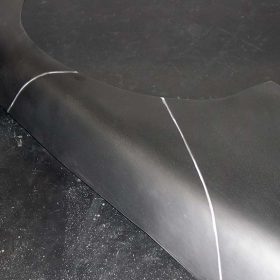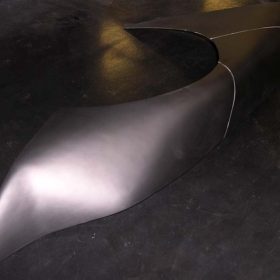3D printed fender prototype, an introduction
3D printed fender prototype in Windform – such as many other parts manufactured in Windform – represents an important innovation in the world of both 3D printing and motorsport.
Currently used in wind tunnel tests, component made from Rapid Prototyping technology in Windform XT Carbon fibre reinforced composite has been directly characterized by comparison with similar component made from carbon fibre.
In this following case, the component was a large part of the car defined as a fender fitted on a Wind tunnel model of Dodge Charger used to race in the Nextel Cup.
Due to his position, the fender is a sensitive part with important effect on the drag (Cx), lift (Cz) and balance of the car.
During wind tunnel run, as usually a map of various ride height with each of these component, the carbon fibre one then the Windform XT one, and standard aero parameters have been measured on the model, drag, lift (= downforce) and balance allowing full post session analyse for others aero parameter like efficiency.
For more indication, baseline was made with carbon fibre fender, and aero map was defined over 7 reference ride heights.
Based on the average values, data show result that was clearly within the repeatability range affecting each wind tunnel.
For obvious confidentiality reason, direct wind tunnel data could not be disclosed but percent error between the two component resulted as follow:
- 0.01% for the Drag
- 0.2% for the lift (= total downforce of the model)
- 0.3% for the front downforce
- 0.08% for the rear downforce
All these are error respect to overall value of the model ( i.e. error of 0.2% between the two parts on the measured downforce respect to the total downforce of the car !!). Again this result was clearly within the range defined by wind tunnel and aerodynamic teams for the typical repeatability (back to back run or placement of part on the model) or overnight repeatability, and confirm stability as well as practical advantage of the Windform XT material over carbon fibre.
Aron Oakley (Penske Racing South, Inc.), explains:
“The Windform XT prototype fender worked flawlessly for our purposes. The surface was accurate and produced acceptable results when compared to the conventional carbon fibre part. The fit and finish were perfect and required very little work to fit the part to the model (just mounting screw provisions). It also significantly reduced the production time.
I actually had your part a few weeks before I had the carbon fibre pieces.
Typically we would have this part made in carbon which would require a CNC cut buck, then a mold, then a part, and then finishing of the part. Or, if we needed a part fast it would be hand made from aluminium.
The quick turnaround allows us to be more accurate with our changes. The part also seems to be more stable than most rapid prototype materials. The stereolithography (SLA) parts seem to keep “growing” over time.
The only drawback to the process is the build size. I would have an entire body made from Windform XT if the build volume was larger!
CRP was able to significantly reduce the production time required for wind tunnel test parts allowing us to test more accurately faster.”


